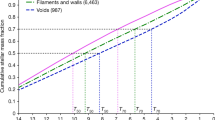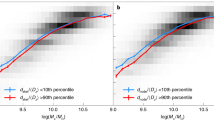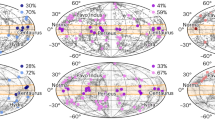Abstract
RECENT galaxy redshift surveys1–3 offer evidence of a quasiperiodic network of 'sheets', with typical dimensions of ~100−1Mpe (h is the Hubble constant in units of 100 km s−1 Mpc−1). Galaxy formation models in which large-scale structure forms purely by gravitational instability from small initial irregularities seem to have problems producing structures on such large scales without violating constraints on the anisotropy of the microwave background, unless they start from apparently contrived initial-fluctuation spectra. Models in which galaxies and clusters have a non-gravitational (possibly explosive) origin seem to be better candidates for the progenitors of large sheets and bubbles, but one would still not expect a perfectly regular lattice. So how surprising are the observations, if they are interpreted in the framework of such models? Here I show that a random cellular model, which mimics the galaxy distribution formed as matter is swept up into shells around expanding void regions or by cosmic blast waves, reproduces the observed Great Walls, voids and periodic structures without undue difficulty.
This is a preview of subscription content, access via your institution
Access options
Subscribe to this journal
Receive 51 print issues and online access
$199.00 per year
only $3.90 per issue
Buy this article
- Purchase on Springer Link
- Instant access to full article PDF
Prices may be subject to local taxes which are calculated during checkout
Similar content being viewed by others
References
De L'apparent, V., Geller, M. J. & Huchra, J. H. Astrophys. J. 302, L1–L5 (1986).
Geller, M. J. & Huchra, J. H. Science 246, 897–903 (1989).
Broadhurst, T. J., Ellis, R. S., Koo, D. C. & Szalay, A. S. Nature 343, 726–728 (1990).
Dirichlet, G. L. J. Reine Angew. Math. 40, 209–227 (1850).
Voronoi, G. J. Reine Angew. Math. 134, 198–287 (1908).
Matsuda, T. & Shima, E. Prog, theor. Phys. 71, 855–858 (1984).
Icke, V. & Van de Weygaert, R. Astr. Astrophys. 184, 16–32 (1987).
Van de Weygaert, R. & Icke, V. Astr. Astrophys. 213, 1–9 (1989).
Yoshioka, S. & Ikeuchi, S. Astrophys. J. 341, 16–25 (1989).
Weinberg, D. H., Ostriker, J. P. & Dekel, A. Astrophys. J. 336, 9–45 (1989).
Stoyan, D., Kendall, W. S. & Mecke, J. Stochastic Geometry and its Applications (Akademie, Berlin, 1987).
Møller, J. Adv. appl. Probab. 21, 37–73 (1989).
Broadhurst, T. J., Ellis, R. S. & Shanks, T. Mon. Not. R. astr. Soc. 235, 827–856 (1988).
Kendall, M. & Stuart, A. The Advanced Theory of Statistics. Vol. 1 4th edn (Griffin, London, 1977).
Kirshner, R. P., Oemler, A., Schechter, P. L. & Schectman, S. Astrophys. J. 248, L57–L60 (1981).
White, S. D. M., Frenk, C. S., Davis, M. & Efstathiou, G. Astrophys. J. 313, 505–516 (1987).
Park, C. Mon. Not. R. astr. Soc. 242, 59P–61P (1990).
Icke, V. Mon. Not R. astr. Soc. 206, 1P–3P (1984).
Coles, P. & Barrow, J. D. Mon. Not. R. astr. Soc. 244, 557–562 (1990).
Author information
Authors and Affiliations
Rights and permissions
About this article
Cite this article
Coles, P. Understanding recent observations of the largescale structure of the universe. Nature 346, 446–447 (1990). https://doi.org/10.1038/346446a0
Received:
Accepted:
Issue Date:
DOI: https://doi.org/10.1038/346446a0
This article is cited by
-
Can cosmic rotation explain an apparently periodic universe?
General Relativity and Gravitation (1994)
-
Voronoi cosmology
Nature (1991)
Comments
By submitting a comment you agree to abide by our Terms and Community Guidelines. If you find something abusive or that does not comply with our terms or guidelines please flag it as inappropriate.



